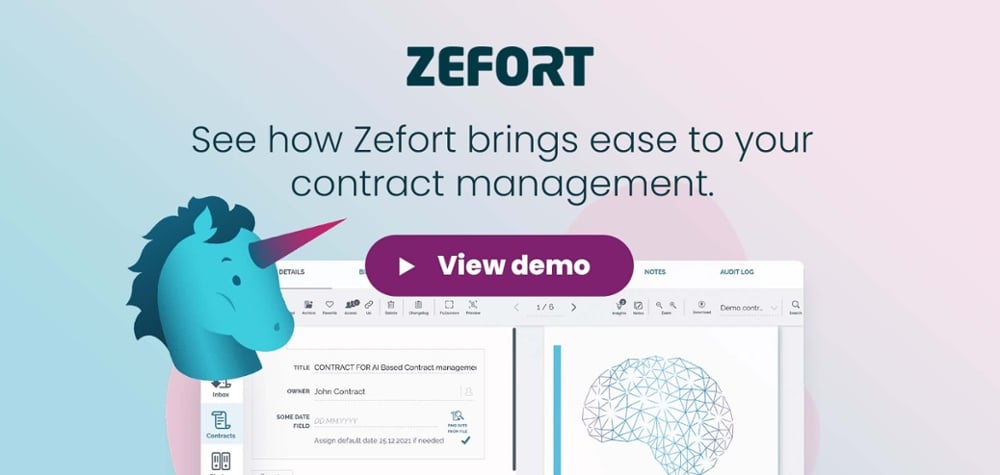Contract management glossary: 31 terms you need to know
As the contract management landscape and the legal tech market is evolving, there’s a constant flow of new terminology and concepts. Here’s your go-to resource for understanding the current discussion around legal technology.
When you want to put the words into action, check out our Comprehensive Guide to Digital Contract Management.
Advanced electronic signature
One of the three levels of electronic signatures defined by the European Union eIDAS digital identification regulation. The other two levels are basic electronic signatures and qualified electronic signatures.
Agreement
Often used synonymously with contract, agreement means an understanding or arrangement made by two or more parties. Formal agreements should always be made in writing, undersigned by representatives from all parties.
AI Agent
A system or entity that can autonomously perceive its environment, make decisions, and take action to achieve specific goals or tasks. It typically consists of sensors to gather information, a decision-making process (often involving algorithms or models), and actuators to interact with the environment.
AI extract
AI extract refers to the technical ability of a contract automation software to process a contract with the help of advanced software algorithms. Artificial intelligence algorithms can, for example, automatically extract contract metadata for uploaded documents. An AI engine can learn from each processed document and improve its performance over time.
Approval phase
Approval phase refers to the part of the contract management process where a contract is internally reviewed and accepted by, typically, high-level management. Approval phase is typically the last step before the contract is signed. A digital contract management solution can support the approval phase by providing version control, reminders and transparency to the approval process.
Audit log
An audit log (also called an audit trail), is essentially a record of events and changes related to contracts. Typically, an audit log captures events by recording who performed an activity, what activity was performed, and what changes were made.
Basic electronic signature
One of the three levels of electronic signatures defined by the European Union eIDAS digital identification regulation. The other two levels are advanced electronic signatures and qualified electronic signatures.
Change history
Change history, or a change log, is a feature in software tools that allows reviewing modifications made to a certain document over time and different document versions. Having access to a change history is especially useful during contract negotiations and contract archival.
Change management
Change management refers to the actions related to contract changes, updates and amendments. Managing contractual changes properly includes documenting the changes in updated versions of the contract itself or attaching the change-related communication, such as emails, to the master contract.
Contract
A contract is a binding, legally-enforceable agreement between specified parties, typically made in writing. A contract takes effect once it has been signed by all contractual parties. Today, contracts are being more and more created, signed and stored exclusively in digital format.
Contract amendment
Amendment refers to a smaller change, update or addition to a contract. A digital contract management solution should allow making small changes easily through version control and by allowing the attachment of change-related information, such as email conversations, to the master contract.
Contract archive
A contract archive is a dedicated storage solution for signed contracts and a key part of the digital contract management solution. Today, modern contract archives come with powerful features such as contract upload automation, AI metadata extraction, full-text search, team sharing and automated reminders. Modern contract archives are secure cloud services, allowing organizations to use them from everywhere.
Contract automation
Contract automation refers to the use of software for making the contract management process more efficient and reducing manual human work. Contract automation can include using smart contract templates in contract creation or automating metadata entry in contract archival, for example. The benefits of contract automation include time and cost savings.
Contract creation
Contract creation is the contract management process phase where the initial contract text is written. Today, contract creation can be made more efficient with smart contract templates that guide and even automate contract creation to a certain extent.
Contract lifecycle
Contract lifecycle means all the various phases of existence for a contract, from contract creation and negotiations to contract termination and long-term archival.
Contract Lifecycle Management, CLM
Contract lifecycle management refers to the planned, proactive management of contracts throughout their existence. Proper contract lifecycle management can increase efficiency, cut contract-related costs and help manage contractual liabilities. Today, there are dedicated CLM solutions that provide software tools for managing the contract lifecycle.
Contract management
Contract management is the process of managing contracts throughout their existence. Today, contract management is more and more done with digital tools that make the work more efficient and allow companies to cut costs, focus their resources and manage liabilities better.
Contract management solution
A software product built for the purpose of making contract management easier. Contract management solutions come with various features, such as contract creation, signing and archival tools. Instead of a single, do-all solution with fixed workflows and processes, companies can also combine separate tools for individual steps, allowing more flexibility over the contract management process.
Contract management system
The same as contract management solution above.
Contract repository
Same as a contract archive, a contract repository is essentially a storage solution for signed contracts. Modern contract repositories allow efficient contract lifecycle management with AI-based contract upload automation, powerful search capabilities, collaboration features and active reminders and notifications.
Data migration
Data migration is the process of moving existing contracts from a legacy solution to a new contract management system. Data migration may include data harmonization (bringing together your data of varying formats and transforming it into one cohesive data set), data cleansing (detecting and correcting (or removing) corrupt or inaccurate records) or data enrichment (merging data from an external source with an existing database to improve the quality of the data set).
Document automation
Document automation refers to the use of technology to streamline the creation, management, and processing of contract documents, reducing manual effort and ensuring accuracy. For example, businesses can generate NDAs, sales agreements, or procurement contracts using standardized templates and predefined workflows, eliminating the need for repetitive drafting.
E-signature
An electronic signature, or e-signature, is a legally binding digital equivalent of a signature on a contract or an agreement, for example. Secure eSignatures can be made with various signing services, such as Zefort Sign.
Liability
Liability refers to all contractual parties’ obligations as defined by the contract. A contract party may be held liable if it fails to meet its obligations, potentially resulting in sanctions as defined by the contract. Having a proper contract management process allows companies to control their liabilities, as they get more transparency and control over their contracts.
Negotiation phase
Negotiation phase is the step where the contracting parties discuss and adjust the terms of the contract. A good contract management software enables efficient negotiation with online collaboration, version control and change tracking features.
Network drive
An archaic solution for storing contracts and other documents, dating back to the times when dinosaurs roamed the Earth. Now replaced with easy-to-use, digital contract archives that work in the cloud and make contracts easy to manage.
Post-sign
Post-sign refers to the contract management process phases that take place after the contract has been signed. These include, for example, storing and archiving the contract, contract renewals, change management and auditing.
Pre-sign
Pre-sign refers to the contract process phases before signing the contract. Such steps include contract creation, negotiation and review and approval phases.
Qualified electronic signature
One of the three levels of electronic signatures defined by the European Union eIDAS digital identification regulation. The other two levels are basic electronic signatures and advanced electronic signatures.
Reminder
Much like notifications, reminders help various stakeholders keep track of important contractual obligations and events. For example, a digital contract management solution can send reminders of contract renewals or termination dates.
Version control
Digital solutions often come with version control features, which essentially means archiving all different versions of a contract. This makes it easy to compare different versions or restore an older version.





